Freestyle swimming is a fundamental stroke that offers a full-body workout and is essential for competitive swimmers and triathletes. Mastering the stroke requires a deep understanding of technique, training zones, and workout structure. This in-depth guide to freestyle drills is designed to enhance your swimming performance by breaking down the essentials of freestyle swimming, from the basics of drills to crafting the perfect swim set, and fine-tuning your technique. Whether you’re a beginner or an experienced swimmer, this guide will provide you with the tools and knowledge to take your freestyle drills to the next level.
Key Takeaways
- Freestyle drills are crucial for improving stroke efficiency and technique, and should be incorporated into regular training.
- Understanding swim training zones, from Z1 to Z5, and determining your Critical Swim Speed (CSS) can optimize your training plan.
- Crafting the perfect swim set involves balancing intensity and volume, and strategically incorporating drills into your main set.
- Navigating swim workouts requires familiarity with common abbreviations and tips for following complex sets, as well as poolside tools for tracking progress.
- Fine-tuning your freestyle includes adjusting workouts for different pool sizes, ramping up intensity based on body feedback, and using evaluations to progress.
Diving Into Freestyle Drills
Breaking Down the Basics
Dipping your toes into the world of swimming can be as exhilarating as it is challenging. When it comes to freestyle for beginners, it’s all about starting with the right drills. Freestyle drills for beginners are designed to build a solid foundation, focusing on form, breathing, and rhythm.
Here’s a simple breakdown to get you started:
- Focus on Breathing: Master the art of bilateral breathing to maintain balance in the water.
- Perfect Your Kick: A consistent, flutter kick helps propel you forward efficiently.
- Streamline Your Stroke: Work on reaching forward and pulling back with minimal drag.
- Rhythm and Timing: Coordinate your strokes with your breathing for a smoother swim.
Embrace the process and be patient with your progress. Each drill is a stepping stone to becoming more confident and comfortable in the water.
Remember, the goal isn’t to rush through the drills but to perform each movement with intention and precision. As you practice, you’ll find your freestyle becoming more fluid and natural. And if you’re ever in need of extra tips or resources, the Swim Time Log offers swimming techniques, nutrition advice, and merchandise to support your journey.
Drills to Enhance Your Technique
If you’re just dipping your toes into the world of swimming, mastering the swimming freestyle technique for beginners can feel like a daunting task. But fear not! With the right drills, you’ll be slicing through the water like a pro in no time.
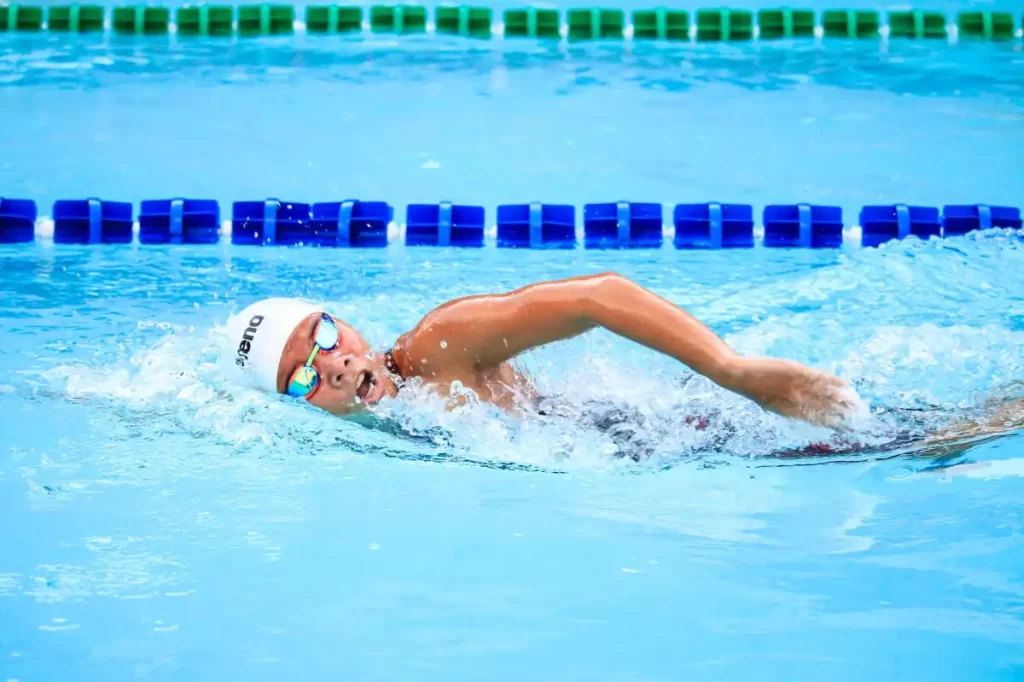
Let’s start with the basics: your kick. The kick in freestyle swimming is your powerhouse, propelling you forward with each flutter. To fine-tune this, freestyle kick drills are your best friend. They help you build strength and endurance in your legs, ensuring that your kick is both effective and efficient.
Breathing might seem natural on land, but in the pool, it’s a whole different ballgame. Drills for breathing in freestyle are crucial for maintaining rhythm and ensuring you’re getting enough oxygen. Here’s a simple drill to practice:
- Swim one length of the pool focusing on your kick and breathing to the side every 3 strokes.
- Rest for 15 seconds.
- Repeat the length, this time breathing every 5 strokes.
This drill not only improves your lung capacity but also teaches you how to breathe in freestyle swim without breaking your stride. Remember, the goal is to keep your head low and turn just enough to catch a breath, not to lift your face fully out of the water.
By incorporating these drills into your routine, you’ll develop a more powerful kick and a breathing technique that feels as natural as walking. And before you know it, you’ll be swimming freestyle with the grace and efficiency of a seasoned swimmer.
Mixing Drills and Sets for Maximum Benefit
When you’re looking to spice up your swim routine, mixing drills with sets can be a game-changer. It’s not just about doing drills; it’s about integrating them into your sets in a way that enhances both your technique and endurance. Here’s a quick breakdown of how you can combine them for maximum impact:
- Start with a warm-up that includes both freestyle swimming and drills to get your muscles ready and your technique dialed in.
- Transition into a main set where you alternate between high-intensity freestyle swims and focused drill work. This keeps your heart rate up while allowing you to concentrate on form.
- Finish with a warm-down that brings your heart rate back down but still incorporates some drill elements to reinforce muscle memory.
By consistently mixing drills into your sets, you’re not only working on your technique but also building strength and endurance. This holistic approach ensures that every part of your workout is contributing to your overall swimming prowess.
Remember, the goal is to make each stroke better than the last. And hey, who knows? You might just find that these drills help you get stronger in ways that benefit all your strokes!
Understanding Swim Training Zones
Decoding the Zones: Z1 to Z5
Understanding swim training zones is like having a secret map to your fitness treasure. Each zone represents a different level of intensity, from light to all-out effort. Zone 1 (Z1) is your chill-out zone, where you can chat with a buddy while doing laps. Zone 2 (Z2) steps it up a bit, perfect for longer swims without huffing and puffing. Zone 3 (Z3) is where the magic happens, pushing you just outside your comfort zone. Zone 4 (Z4) is the ‘no talk zone’, demanding focus and power. Lastly, Zone 5 (Z5) is your max effort, the sprint zone where you leave everything in the pool.
To really get the hang of these zones, let’s dive into an example workout. It’s a mix of pulling and freestyle, sprinkled with rest periods to keep you sharp. You’ll start with a warm-up, cruise through the main set, and then wind down with a warm-down. It’s a full journey from Z2 to Z5, ensuring a refreshing and comfortable swim.
Here’s a quick breakdown of a typical swim set using these zones:
- Warm Up: Start with 100 freestyle in Z2, add some kicks, and take a short rest.
- Main Set: Alternate between pulling in Z2 and ramping up to freestyle in Z3, Z4, and Z5, with rests in between.
- Warm Down: Finish with a gentle 50 freestyle in Z2, followed by a stroke of your choice.
Remember, the key to mastering these zones is not just knowing them, but feeling them in the water. It’s about syncing your body’s effort with the zone’s demand, creating a symphony of speed and endurance.
How to Determine Your Critical Swim Speed (CSS)
Understanding your Critical Swim Speed (CSS) is like having a personal benchmark for your swim training. It’s the pace you could theoretically maintain for a long swim without fatigue. To find your CSS, you’ll need to do a bit of testing and math. Start with two time trials: a 400m and a 200m swim. Make sure to push off the wall for a clean start, not a dive, and go all out. Record your times for both distances.
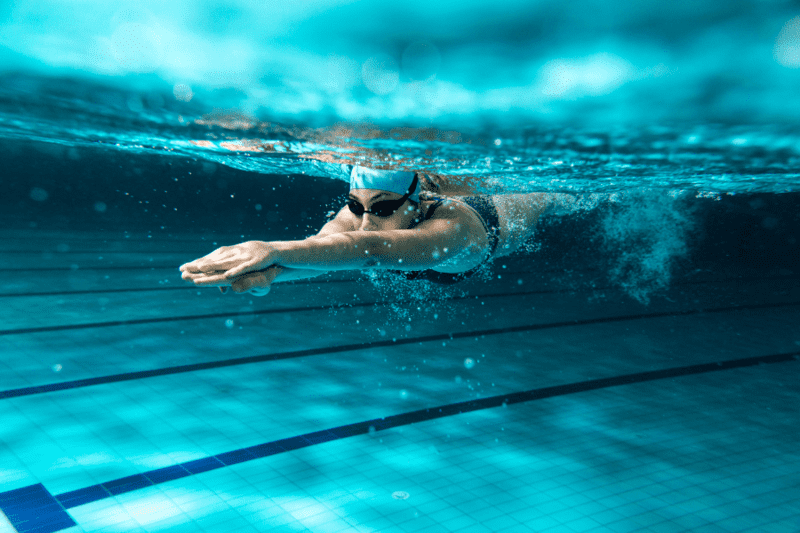
Once you have your times, you can use an online calculator or a simple formula to determine your CSS. This value is crucial for setting accurate training zones and tailoring your workouts for improvement.
Here’s a quick guide to calculate your CSS:
- Perform a maximal 400m time trial and note your time.
- Do the same for a 200m swim.
- Use the difference in seconds between the two times to calculate your CSS pace per 100m.
Remember, your CSS isn’t static; it will change as you get fitter. Regularly retesting every few weeks can help you track your progress and adjust your training zones accordingly.
Applying Zones to Your Training Plan
Once you’ve got your Critical Swim Speed (CSS) figured out, it’s time to put those swim training zones to work. Tailoring your workouts to your specific zones ensures that you’re training at the right intensity to meet your goals. Here’s a quick rundown on how to apply those zones:
- Z1: Recovery and warm-up/cool-down sessions
- Z2: Base endurance training
- Z3: Moderate intensity, aerobic capacity work
- Z4: High-intensity, anaerobic threshold sessions
- Z5: Sprint and speed work
By consistently training in the appropriate zones, you’re setting the stage for measurable improvements. This strategic approach allows you to focus on different aspects of your performance, from building endurance to honing your speed.
Remember to update your CSS and training zones in your TrainingPeaks settings. This will help you see the planned distance and duration for all your workouts. And don’t forget, you can always tweak your plan as you progress—listen to your body and adjust accordingly!
Read more: Revolutionize Your Swim: Freestyle Drills for All Skill Levels
Crafting the Perfect Swim Set
Balancing Intensity and Volume
Crafting the perfect swim set is a delicate dance between pushing your limits and not overdoing it. Finding the right balance between intensity and volume is crucial for improving performance without risking burnout or injury. Here’s a simple breakdown to help you structure your workouts effectively:
- Volume refers to the total distance or time spent swimming during a workout.
- Intensity relates to the speed or effort level, often guided by different training zones.
When planning your sets, consider alternating between periods of high-intensity and low-intensity swimming. This approach not only boosts cardiovascular fitness but also enhances speed. For instance, a workout might involve a main set where you switch from a moderate Zone 2 to a challenging Zone 4, followed by a rest period. Here’s an example:
| Set | Distance and Stroke | Zone | Rest |
|---|---|---|---|
| 1 | 100 Pull | Z2 | 20 sec |
| 2 | 200 FS | Z3 | 20 sec |
| 3 | 100 Pull | Z2 | 20 sec |
| 4 | 100 FS | Z4 | 20 sec |
By incorporating a variety of zones and rest intervals, you can create a workout that caters to all levels, helping to improve your skills while keeping things fresh and challenging.
Remember to listen to your body and adjust the intensity and volume as needed. Your training should be a progression, gradually increasing in difficulty as your fitness improves.
Incorporating Drills into Your Main Set
Spicing up your main set with drills is like adding a secret sauce to your swim workout. It’s not just about grinding out the meters; it’s about refining your technique to swim smarter, not harder. Incorporating drills into your main set can significantly enhance your stroke efficiency and speed.
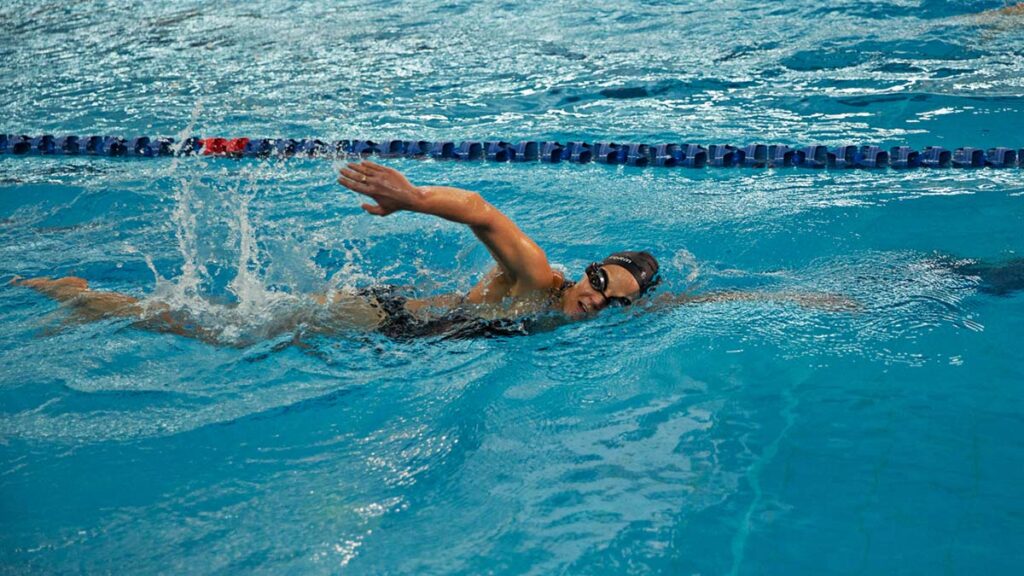
For instance, you might kick off your main set with a 100 Pull in Z2, focusing on your pull technique. Follow this with a 200 Freestyle in Z3, where you can apply the improved pull to your overall stroke. Here’s a snapshot of how a drill-infused main set might look:
| Reps | Drill | Intensity Zone | Rest Period |
|---|---|---|---|
| 2x | 100 Pull | Z2 | 20 secs |
| 3x | 100 FS | Z4 | 20 secs |
By alternating between pull drills and higher intensity freestyle swims, you’re not only building endurance but also reinforcing good habits.
Remember, the goal is to transition smoothly from drill to swim, so that each stroke during your main set feels as natural and effective as possible. The drill combination that will improve your catch is a simple yet powerful way to use these strategies together. After setting up the stroke, perform a wall pull for 5 seconds, then continue swimming with the refined technique.
Warm Up and Warm Down: The Bookends of Your Workout
Think of your warm up and warm down as the appetizer and dessert of your swim feast. They’re not just about getting your muscles ready or cooling them down; they’re about setting the tone and wrapping up the experience with a sense of completion.
Warm ups kickstart your engine, gradually revving up your cardiovascular system and prepping your muscles for the workout ahead. They typically involve a mix of freestyle swimming and drills, all performed at a lower intensity to ease your body into the main set.
Here’s a quick breakdown of a typical warm up:
- 100m freestyle (FS) in Zone 2 (Z2)
- 100m kick in Z2
- 15 seconds rest
- Repeat with drills and pulls
On the flip side, warm downs are your chance to decelerate. They help in flushing out lactic acid, reducing the risk of soreness, and mentally transitioning from workout to rest. A simple warm down might include:
- 50m freestyle in Z2
- 50m stroke of your choice in Z2
- Repeat and enjoy the calm after the storm.
While the main set is where the magic happens, never underestimate the power of a good warm up and warm down. They protect your body and enhance your overall training session.
Navigating Your Swim Workouts
Deciphering Swim Set Abbreviations
Swim workouts can sometimes look like a secret code, but don’t let that intimidate you. Understanding the shorthand can streamline your pool time and keep you focused on the workout itself. Let’s break down some common abbreviations you’ll encounter:
- FS stands for Freestyle, the stroke you’re likely spending most of your time perfecting.
- Z1 through Z5 refer to Training Zones 1 through 5, dictating the intensity of your swim.
- secs and mins are simply shorthand for seconds and minutes, crucial for timing your rests and intervals.
When you see a set like ‘2 x (100 Drill in Z2 + 100 Pull in Z2 + 15 sec rests)’, it’s telling you to do two rounds of 100 meters of a drill in Zone 2 intensity, followed by 100 meters of pulling (using a pull buoy), with 15 seconds of rest in between.
Once you’ve got these basics down, you’ll start to see patterns and be able to anticipate the flow of your workout. Remember, the goal of these abbreviations is to make your swim sets easier to follow, not harder!
Tips for Following Complex Swim Sets
Diving into a complex swim set can feel like you’re trying to decipher an ancient code. But fear not! With a bit of practice, you’ll be navigating these waters like a pro. Start by breaking down the set into its individual components. This will help you understand the purpose behind each part and how they fit together.
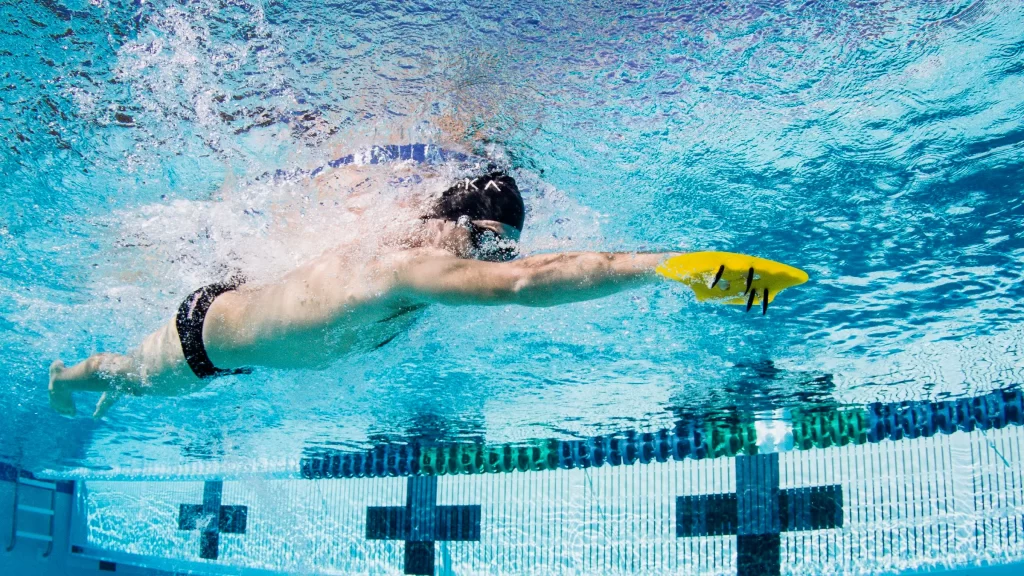
For example, a typical set might include a mix of different strokes and intensities, often indicated by training zones (Z1 to Z5). Here’s a quick reference to keep track of what each abbreviation means:
- Z1 = Training Zone 1
- Z2 = Training Zone 2
- Z3 = Training Zone 3
- Z4 = Training Zone 4
- Z5 = Training Zone 5
- secs = Seconds
- mins = Minutes
- Kick = Kicking on your front while holding a kick float at arm’s length
- Pull = Front crawl with pull buoy float between thighs
- FS = Freestyle or front crawl
- Back = Backstroke
- Breast = Breaststroke
- Choice = Any stroke or swim drill
When you’re in the thick of a swim session, it’s easy to lose track of where you are in the set. A good strategy is to mentally rehearse the set before jumping in. Visualize each segment and the transitions between them.
Remember, the goal is to combine different swim drills for big performance gains, as swim coach Andrew Sheaff suggests. Whether you’re working on endurance or speed, the right combination of drills can make all the difference.
Keeping Track Poolside: Tools and Tricks
Keeping a handle on your swim sets while you’re at the pool can be a game-changer for your training. Exporting your workouts to a training device like a Garmin or Suunto can streamline the process, allowing you to focus on your form rather than counting laps. Most devices sync with apps like TrainingPeaks, where you can set your pool length and track your progress over time.
For those who prefer a more tactile approach, consider bringing a printed copy of your workout in a waterproof sleeve. A small whiteboard can also serve as a handy tool, letting you tick off sets as you complete them.
Understanding the shorthand used in swim workouts will save you time and confusion. Here’s a quick reference to some common abbreviations you might encounter:
- IM: Individual Medley
- FR: Freestyle
- BK: Backstroke
- BR: Breaststroke
- FL: Fly
Remember, the key to effective training is not just the workout itself, but how you manage and track it poolside.
Fine-Tuning Your Freestyle
Adjusting Workouts for Pool Size: Meters vs. Yards
Switching between a 25-yard pool and a 50-meter one can mess with your head, not to mention your swim sets. But hey, it’s all part of the fun, right? When you’re toggling between the two, remember that your pace and distance will shift. A quick tip: workouts in meters tend to be about 10% longer than their yard counterparts, so adjust accordingly.
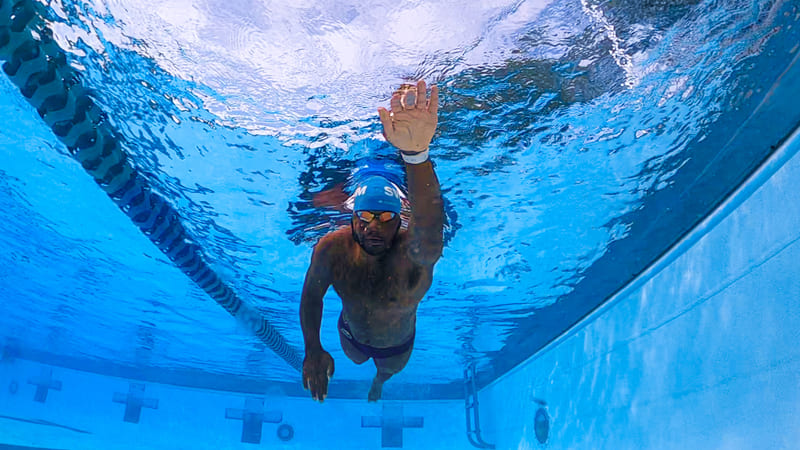
Here’s a simple way to keep track:
- If your set says swim 100 yards and you’re in a meter pool, aim for 110 meters.
- Flip it, and for 100 meters in a yard pool, you’ll do about 90 yards.
Don’t sweat the small stuff. Your body won’t know the difference between 100 yards and 110 meters. It’s the effort that counts, not the exact distance.
For those diving into freestyle swimming, whether you’re soaking up freestyle swimming tips for beginners or marveling at Michael Phelps’ freestyle, the key is consistency. Stick to the freestyle swimming steps, and you’ll be slicing through the water in no time.
When to Ramp Up Intensity: Listening to Your Body
Knowing when to crank up the intensity in your swim workouts is more art than science. It’s about tuning in to your body’s signals and understanding your current fitness level. If you’re breezing through sets that once left you breathless, it might be time to push a little harder. But how do you decide when and how much to increase the intensity? Here’s a simple guide:
- Listen to your body: Are you recovering well between sessions? No lingering fatigue or soreness?
- Check your times: If you’re consistently beating your previous bests, your body is ready for more.
- Assess your technique: Ensure that increasing speed doesn’t mean sacrificing form.
It’s crucial to strike a balance between pushing your limits and allowing adequate recovery. Overdoing it can lead to burnout or injury, so always err on the side of caution.
Remember, increasing intensity isn’t just about swimming faster or harder. It can also mean tweaking your workout structure, like incorporating more high-intensity intervals or reducing rest times between sets. Use the feedback from your body and your times to guide you.
The Role of Feedback: Evaluating Your Progress
Getting feedback on your swimming technique is crucial. It’s like having a coach’s eye on you, constantly tweaking and improving your form. Feedback helps you identify the strengths and weaknesses in your stroke, allowing you to focus on areas that need the most work.
Feedback isn’t just about what you’re doing wrong; it’s also about reinforcing what you’re doing right. Celebrate the small victories along the way!
Here’s a simple way to track your progress over time:
- Record your swim times and distances regularly.
- Note any changes in your technique or how you felt during the swim.
- Compare your data periodically to see trends and improvements.
By keeping a log, you can see just how far you’ve come. It’s not just about swimming faster; it’s about swimming smarter. And remember, progress is rarely a straight line. There will be ups and downs, but the overall trajectory should be upward.
Elevate your swimming prowess with our expert tips on ‘Fine-Tuning Your Freestyle’. Dive into a sea of knowledge and refine your technique to glide through the water with ease. Don’t just swim—excel! Visit our website for comprehensive guides, personalized advice, and the latest in swim gear. Make every stroke count and join our community of swimming enthusiasts today. Click here to start your journey to becoming a freestyle virtuoso.
Conclusion
Alright, water warriors, that’s a wrap on our freestyle drill guide! Remember, practice makes perfect, so don’t be shy to take these drills and make a splash at your local pool. Whether you’re a newbie getting your fins wet or a seasoned swimmer looking to refine your technique, these drills are your ticket to gliding through the water with ease. Keep experimenting with your swim sets, embrace the training zones, and always remember to warm up and cool down. Dive into these tips and tricks, and you’ll be swimming circles around the competition in no time. Until next time, keep those strokes sleek and your spirits high!
Read more: Freestyle Swimming Foundations: A Beginner’s Guide to Getting Started
AUTHOR
Sang Nguyen
Sang Nguyen is a former national swimmer for Vietnam who has transitioned into coaching. With a passion for fostering a healthy swimming community and connecting like-minded individuals,......Read More
BLOG
Maybe You Are Interested
Good Swim Meet Snacks: What to Eat for Optimal Performance
Good nutrition is crucial for swimmers to maintain energy, recover quickly, and perform at their...
Read More...Optimizing Your Performance: The Best Diet for Swimming Training
Optimizing your performance in swimming is not just about rigorous training; it’s equally crucial to...
Read More...Achieve Peak Performance with This Diet Chart for Swimmers
Whether you’re a novice or an expert swimmer, understanding the right diet is crucial for...
Read More...Eating Like a Champion: Exploring the Diet of Michael Phelps
Michael Phelps, renowned for his Olympic triumphs, has a diet as extraordinary as his swimming...
Read More...Muscle Gain for Swimmers: Tailoring Your Diet for Strength
Swimming is a demanding sport that requires a tailored approach to nutrition to support muscle...
Read More...A Comprehensive Diet Plan To Gain Weight For Swimmers
Swimming is a demanding sport that requires meticulous attention to nutritional needs to optimize performance,...
Read More...